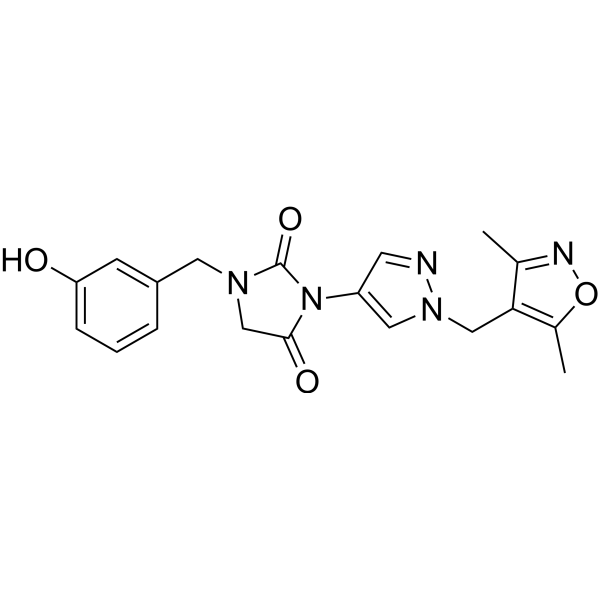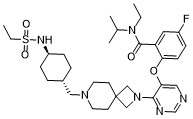 To enhance service speed and avoid tariff delays, we've opened a US warehouse. All US orders ship directly from our US facility.
To enhance service speed and avoid tariff delays, we've opened a US warehouse. All US orders ship directly from our US facility.
| Cat. No. | Product Name | Field of Application | Chemical Structure |
|---|---|---|---|
| A248 | Guselkumab Biosimilar(Anti-IL-23 Reference Antibody) Featured |
Guselkumab is a recombinant human IgG1 monoclonal antibody against the IL-23p19 subunit. Guselkumab binds to human and cynomolgus monkey IL-23 with Kd values of 3.3 and 1.9 pmol/L, respectively. Guselkumab inhibits production of cytokines lying downstream of the IL-23 signaling pathway and can be used for psoriatic arthritis research.
More description
|
.png)
|
| A247 | ARGX-112 Biosimilar(Anti-IL-22Ra Reference Antibody) Featured |

|
|
| DC73509 | S6821 Featured |
S6821 (S 6821) is a potent and selective antagonist of the bitter taste receptor TAS2R8, exhibiting an IC50 value of 21 nM.
It demonstrates high selectivity across a panel of 16 TAS2Rs, effectively reduces the bitterness of coffee, and shows an excellent safety profile.
More description
|

|
| A246 | Fezakinumab Biosimilar(Anti-IL-22 Reference Antibody) Featured |
Fezakinumab is an interleukin-22 (IL-22) monoclonal antibody. Fezakinumab can be used for the research of inflammatory disease, such as psoriasis and rheumatoid arthritis.
More description
|
.png)
|
| A245 | Lilly patent anti-IL-21 Biosimilar(Anti-IL-21 Reference Antibody) Featured |

|
|
| A244 | Avizakimab Biosimilar(Anti-IL-21 Reference Antibody) Featured |
Avizakimab (BOS161721) is a humanized IgG1 monoclonal antibody that targets interleukin-21.
More description
|
.png)
|
| A243 | Cheng Kung U. patent anti-IL-20R1 Biosimilar(Anti-IL-20Ra Reference Antibody) Featured |

|
|
| A242 | Cheng Kung U. patent anti-IL-20 Biosimilar(Anti-IL-20 Reference Antibody) Featured |

|
|
| A241 | Fletikumab Biosimilar(Anti-IL-20 Reference Antibody) Featured |
Fletikumab (NNC0109-0012) is a monoclonal antibody targeting to IL-20. Fletikumab can be used for inflammation research, such as rheumatoid arthritis.
More description
|
.png)
|
| A240 | Imsidolimab Biosimilar(Anti-IL-1RL2 / IL-36R Reference Antibody) Featured |
Imsidolimab (ANB 019) is a high-affinity, humanized monoclonal antibody of anti-IL-36R. Imsidolimab antagonizes IL-36 cytokine signal transduction. Imsidolimab has potential application in generalized pustular psoriasis (GPP) and other inflammatory skin diseases.
More description
|
.png)
|
| A239 | Astegolimab Biosimilar(Anti-IL-1RL1 / ST2 / IL-33R Reference Antibody) Featured |
Astegolimab (MSTT 1041A; RG 6149) is a human IgG2 monoclonal antibody that blocks IL-33 signaling by targeting ST2, the IL-33 receptor. Astegolimab has the potential for chronic obstructive pulmonary disease (COPD) research.
More description
|
.png)
|
| A238 | Melrilimab Biosimilar(Anti-IL-1RL1 / ST2 / IL-33R Reference Antibody) Featured |
Melrilimab (GSK 3772847) is an IgG2-kappa anti-IL1RL1/ST2/IL33R/DER4/FIT-1 monoclonal antibody. Melrilimab can be used for the research of asthma.
More description
|
.png)
|
| A237 | Nidanilimab Biosimilar(Anti-IL-1RAP / IL-1R3 Reference Antibody) Featured |
Nidanilimab (CAN04) is a fully humanized monoclonal anti-IL1RAP antibody with a Kd value of 1.10 pM. Nidanilimab blocks IL1α and IL1β signaling and stimulates the immune system to destroy tumour cells. Nidanilimab can be used in research of non-small lung cancer (NSCLC) and pancreatic ductal adenocarcinoma (PDAC) .
More description
|
.png)
|
| A236 | AMG 108 Biosimilar(Anti-IL-1R1 / CD121a Reference Antibody) Featured |

|
|
| A235 | Canakinumab Biosimilar(Anti-IL-1b Reference Antibody) Featured |
Canakinumab (ACZ885) is a recombinant human anti-IL-1β monoclonal antibody. Canakinumab shows IC50 values of 43.6 and 40.8 pM for human and marmoset IL-1β, respectively. The mode of action of canakinumab is based on the neutralization of IL-1β signaling, resulting in suppression of inflammation related to disorders of autoimmune origin.
More description
|
.png)
|
| A234 | CDP484 Biosimilar(Anti-IL-1b Reference Antibody) Featured |

|
|
| A233 | Gevokizumab Biosimilar(Anti-IL-1b Reference Antibody) Featured |
Gevokizumab is a potent anti-IL-1β antibody, negatively modulates IL-1β signaling through an allosteric mechanism. Gevokizumab selectively decreases the binding affinity of IL-1β for the IL-1 receptor type I (IL-1RI) signaling receptor instead of IL-1 counter-regulatory decoy receptor (IL-1 receptor type II).
More description
|
.png)
|
| A232 | ABT-325 Biosimilar(Anti-IL-18 Reference Antibody) Featured |

|
|
| A231 | GSK 1070806 Biosimilar(Anti-IL-18 Reference Antibody) Featured |

|
|
| DC20045 | GGsTop (Nahlsgen) Featured |
GGsTop (Nahlsgen) is a potent, non-toxic, highly selective and irreversible γ-GGT inhibitor, with a Ki of 170 μM for Human GGT. GGsTop shows a pKa of 9.71, also exhibits Kons of 150 and 51 M-1 s-1 against E.coli GGT and human GGT, respectively. GGsTop protects hepatic ischemia-reperfusion injury in rat model.
More description
|

|
| DC10304 | RA190 Featured |
RA190, a bis-benzylidine piperidon, inhibits proteasome function by covalently binding to cysteine 88 of ubiquitin receptor RPN13.
More description
|
|
| DC45758 | Revumenib Featured |
SNDX-5613 is a potent and selective inhibitor of menin-MLL binding with a Ki of 0.15 nM. SNDX-5613 shows anti-proliferative activity against multiple cell lines harboring MLLr translocations (MV4;11, RS4;11, MOLM-13, KOPN-8) with IC50 values ranging from 10-20 nM.
More description
|

|
| DC67097 | DSPE-PEG(2000)-amine (sodium salt) Featured |
DSPE-PEG(2000)-amine is a PEGylated derivative of 1,2-distearoyl-sn-glycero-3-PE (DSPE; Item No. 15095). It has been used in the synthesis of solid lipid and thermosensitive liposomal nanoparticles for the delivery of anticancer agents. DSPE-PEG(2000)-amine has also been used in the synthesis of fluorescein isothiocyanate-loaded mesoporous silica nanoparticles for imaging applications.4 It can be conjugated to a variety of functional molecules for improved cellular targeting and uptake of DSPE-PEG(2000)-amine-containing nanoparticles.
More description
|

|
| DC66166 | DSPE-PEG-Glucose;DSPE-PEG2000-Glucose Featured |
Glucose, organic compound, molecular formula C6H12O6. It is one of the most widely distributed and important monosaccharides in nature, and it is a polyhydroxyaldehyde. Glucose plays an important role in the field of biology, that is, the main energy supplier of living things. Plants produce glucose through photosynthesis. Liposome has the advantages of low toxicity, easy preparation, as a carrier of both water-soluble and fat-soluble drugs, suitable for a variety of drug delivery routes, improve drug stability, and achieve targeted drug delivery. However, after the liposome enters the body, it is easy to be taken up and cleared by RES cells due to the specific conditioning effect of opsonins in plasma on the liposome and the non-specific hydrophobic interaction between RES cells and liposome.
More description
|

|
| DC66268 | DSPE-Hyd-PEG-Mal (MW 2000) Featured |
DSPE-Hyd-PEG, also known as distearoylphosphoethanolamine-hydrazide-polyethylene glycol, is a type of lipid-based polymer that has various applications in drug delivery and biomedical research.
One of the main applications of DSPE-Hyd-PEG is in the field of targeted drug delivery. It is often used as a component of liposomes or lipid nanoparticles to improve the stability and targeting ability of drug carriers. DSPE-Hyd-PEG can be conjugated with targeting ligands, such as antibodies or peptides, to specifically bind to receptors on the surface of target cells. This targeted drug delivery system allows for more efficient and selective delivery of therapeutic agents to the desired site, while minimizing off-target effects.
More description
|

|
| DC65966 | DSPE-PEG2000-triGalNAc ammonium Featured |
DSPE-PEG2K-triGalNAc is a polar lipid composed of DSPE and tri-N-acetylgalactosamine that can be used to construct liposomes target to asialoglycoprotein receptor (ASGPR).
More description
|

|
| DC49306 | DSPE-PEG-Maleimide (MW 2000) Featured |
DSPE-PEG-Maleimide, MW 2,000 is a PEG compound with DSPE and maleimide groups. The DSPE-PEGs have been FDA approved for medical applications. The hydrophobic properties of the DSPE allow for the encapsulation and congregation of other hydrophobic drugs. The hydrophilic polyPEG increases the water solubility of the overall compound allowing for the delivery of the drug. Maleimide groups can react with thiol groups between pH 6.5 to 7.5.
More description
|

|
| DC66296 | DSPE-PEG-alkyne (MW 2000) Featured |
The phospholipid polyethylene glycol alkyne (DSPE PEG Alkyne) can be used to modify proteins, peptides and other materials or small molecules. Alkynyl (- ALK) can react with copper catalyzed azide in aqueous solution. 2-Distearoyl-sn-Glycero-3-Phosphoethanolamine (DSPE) conjugated polyethylene glycol is a combination of phospholipid and polyethylene glycol with hydrophilicity and hydrophobicity. Polyethylene glycol phospholipid liposomes form high-quality materials, which can be used for drug delivery, gene transfection and vaccine delivery. PEGylated phospholipid can significantly improve blood circulation time and stabilize drug encapsulation. These materials can also be used for targeted drug delivery by modifying ligands with target surfaces such as antibodies and peptides.
More description
|

|
| DC66149 | DSPE-m-PEG-NHS (MW 3400) Featured |
DSPE-m-PEG-NHS (MW 3400) is a pegylated phospholipid derivatives which can be used to prepare liposome or lipid nanoparticles for targeted drug delivery system, such as DNA or mRNA vaccine.
More description
|

|
| DC66112 | DSPE-PEG-Biotin (MW 2000) Featured |
DSPE-PEG-Biotin (MW 1000) is a PEG-based PROTAC linker
More description
|

|